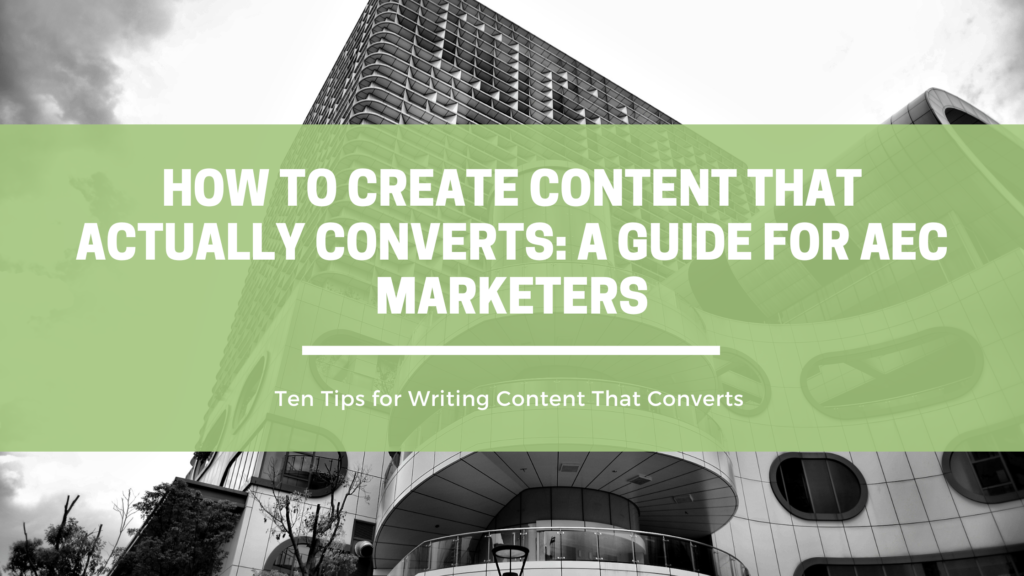How to Create AEC Content That Converts

The goal of any content marketing strategy is to sell something – to make money – and turn readers into customers. The better your content marketing strategy, the more money you make, right?
Unfortunately, the answer to that question is no. The best content marketing strategy in the world is worthless, if the content you write does not convert. Fortunately, this content marketing guide for AEC marketers has everything you need to write content that compels readers to engage and, most importantly, open their wallet.
Ten Tips for Writing Content That Converts
Before we get started, it’s important to note that all content is created with purpose. It’s supposed to do something. From sales, to brand awareness or simply climbing the SERP, we content marketers do not create content without purpose.

To do so is a self destructive act that leaves your readers guessing, and the firm accountants wondering why they invest in your department. Thus, the first step – before you write a single word – is to establish your goal. What do you want the content to achieve? Why are you doing this? Answer those questions before you do anything else. Here are several good reasons to get you started:
- Foster Brand Awareness
- Sell a Product
- Make an Announcement
- Educate Your Readers
- Grow Your Audience
- Improve Your SERP(Search Engine Results Page) Ranking, and
- Move Potential Clients to the Next Stage of the Buying Funnel.
Whatever your goal, just be sure that you have one. Otherwise you’re just wasting your time and resources.
What is a Content Marketing Funnel
Now that you’ve determined the purpose of the content, it’s time to delve into research to determine where your audience lies in the buying process. The goal here is to determine what type of content will be most effective in moving them to the next stage. This is called your content marketing funnel, and it can be broken into three stages:
- Top of the funnel (TOFU): attracts attention
- Middle of the funnel (MOFU): generates leads
- Bottom of the funnel (BOFU): drives conversions
Below we take a closer look at the content marketing funnel to determine which content is most suitable for each stage.
Top of the Funnel (TOFU): Spark Interest

The top of the funnel is the starting point of the buyer journey, and also the most populated stage. In this stage readers are not yet ready to buy and unlikely to have heard of your company before. The goal here is fourfold:
- attract attention,
- offer the best answer to queries,
- educate your audience, and
- gently introduce readers to your brand.
The most effective types of content for this stage tend to be educational and provide a piece of value, which helps drive users to your website. According to a SEMRush study, these are the top five types of content that work best on top of the funnel readers:
- “How-to” guides
- Landing pages
- Infographics
- Checklists
- Ebooks
TOFU content like this is typically found organically, i.e. the reader queried Google and found the content on the SERP. To capture potential customers at this stage, it’s best to focus on educating the reader, providing value, and sparking their interest in your brand.
Middle of the Funnel (MOFU): Guide and Educate

At the middle-of-the-funnel stage, the number of people interacting with your content is likely to shrink slightly, but that’s a good thing as these readers are more willing to interact with your content given the proper encouragement.
The goal at this stage of the content marketing funnel is to accompany the prospect from an initial idea to an in-depth understanding of how your solution helps them solve an issue. The types of content most commonly consumed at this stage are:
- “How-to” guides
- Product overviews
- Case studies
- Landing pages
- Webinars
These content types are more product-oriented and designed to help nurture prospective customers into seeing the true benefits of your product or service. It also presents another opportunity for readers to engage with your brand and encourage them to move onto the next stage.
Bottom of Funnel (BOFU): Enable Conversion

The bottom-of-the-funnel stage is the finish line, where content is designed to help position your brand as superior to your competitors, build trust in your product, and accelerate the purchase of your solution.
The content you create at this stage should answer very specific questions about your product or service (e.g., how it actually works or what skills are required to use it). Things like:
- Product overviews
- Customer reviews
- Success stories
These are valuable resources for convincing a prospect to choose from what you have to offer. Fortunately, a majority of marketers already create content that speaks to at least one part of the content marketing funnel.
How to Create High-Converting Content: A Step-by-Step Guide
Now that you have determined the purpose of the content and buying stage of the prospect, you can start writing your content. There is just a little more research that you need to do before you start typing.
Step One: Research Your Topic
To create high-converting content, the first thing you need to do is research your topic to determine its effectiveness. Tools like SEMRush make this process much easier, but you don’t need to subscribe to expensive SEO tools to research a topic. A simple Google search will reveal quite a bit about your topic, your competitors and your audience.
The above screenshot reveals our topic in greater detail, and provides several resources on which you can build. This is called the skyscraper effect, in which you use your competitor’s content as a guide for building yours.
The goal here is not to copy your competitors, but to identify the parts of their content that work well, then infuse that asset into your content. You should also utilize the “People also ask” and “Related searches” sections to identify the questions that you should answer and some of the keywords you should use.
Step Two: Establish Your Keywords
The next step to creating high-converting content is to establish your keywords by conducting keyword research. The power of keyword research lies in better understanding your target market and how they search for your content, services, or products.
This guide from Moz is a useful resource that should provide the understanding you need to conduct keyword research and infuse the proper keywords into your content.
Step Three: Write a Killer Headline
Step three gives us our first chance to actually start writing. Here is where you craft your headlines. This is a very important stage, as your headline is the first thing readers notice about your blog post or landing page content.
The more captivating your headline, the more likely the reader is to continue with the rest of the content. So, write a good one or the reader will bounce from the page. This guide from the Content Marketing Institute should help you craft a killer headline.
Step Four: Include Headers With Focus Keywords
The next step is to utilize headers to create a basic outline for the rest of the content. Be sure to utilize the keywords you discovered during your keyword research, as they will infuse your content with greater SEO value. This guide from Search Engine Journal will show you how to use header tags like a pro.
Step Five: Write an Intriguing Introduction
If your headline is designed to captivate the reader, your intro should make them want to read more. For blog posts, the first three to four sentences are considered your intro. They should quickly get to the point and clearly explain how the reader will benefit from reading your article. This guide from the Content Marketing Institute has everything you need to write an effective introduction to your content.
Step Six: Pay Attention to Format
The next factor that influences your content’s ability to convert is the format. Your format should be broken into small, useful sections, thereby making it easier for the reader to consume.
Avoid large sections of text that make your content difficult to read and hurt your conversion rate because people don’t want to have to work hard to glean the details. This guide from HubSpot will show you how to format your content most effectively.
Step Seven: Write a Compelling Call to Action (CTA)
Your call to action (CTA) is the most important part of your content because it compels the reader to take the action that you want them to take. Most CTA’s are found at the end of the content, where they urge people to subscribe to your newsletter or download your latest e-book.
CTA’s can also be found on your landing pages, where they encourage users to purchase your product or service. Wherever you place your CTA, be sure that it is compelling, and driving traffic to your product. This guide from Wordstream will walk you through the process of writing a compelling CTA.
Step Eight: Write for People, Not Machines
The most important thing you can do to write content that actually converts is to write for people, not the Google algorithm. Though keywords, format, and headers are important, you still need to write for the reader, not a machine.
Avoid keyword stuffing, and blindly writing to rank as high as you can on the SERP. So long as you follow this step-by-step guide and create high quality content, you will see your listings rise in the search engine results page. This article from God Save the SERP has everything you need to write for humans, not Google.
Step Nine: Be Sure to Include Visuals
Step nine is to include visual elements that not only break up the blocks of text on the page, but also provide a large boost in search performance and conversion rates. Visuals also attract and engage your readers while adding more substance to content. The best kinds of visuals largely depend on the type of content you’re creating. These five types digital assets can help you increase conversions:
- Images – A BuzzSumo study of over 1 million articles found articles with images every 75 to 100 words earned double the shares of articles with fewer images. Though the study was done in 2017, the popularity of visuals with audiences has only grown.
- Videos – Images or text alone may be insufficient for explaining how a product works or how people can benefit from it. You could include a short explainer video on your landing page to help boost conversions.
- Infographics – Complex data and complicated concepts can be difficult to understand with words alone. In these instances, infographics can be helpful in explaining or illustrating the information.
- Charts – If you quote studies or stats to support your points, include charts and graphs to illustrate them. Charts or graphs alongside the text make it easier for readers to process the information.
- Screenshots – If you explain how something works, screenshots can enrich your content. They can also explain a process visually in ways words cannot adequately express.
- Original Graphics – Taking time to come up with something valuable and original shows readers your content is unique. Even if you don’t have an in-house designer to help you with this, you can always use tools like Canva to help you create them
Step Ten: Optimize Your Content
Once your content is complete, it’s time to optimize it for search. Here is where you add alt tags to images, write your meta description, add backlinks and carry out a small list of other tasks that make your content easy for people to find and consume online. This guide from SEMRush will help you optimize your content with ease.
Make Content Marketing Easy: Invest in a Digital Asset Management (DAM) System

The more content that you create for your audience, the more visuals you will use, share and need to manage. These digital assets add up quickly, hogging valuable space on your drive and making it difficult to find the assets you need, when you need them. That’s where digital asset management comes in.
In fact, research shows that marketers spend over 60% of their time retrieving information or restructuring lost assets and other low-value tasks. Digital asset management software works by creating workflows that enable your team to find, store and share the files they need to work most effectively.
Get Started With OpenAsset Today
Unlike traditional DAM systems, OpenAsset is a project-based digital asset management solution specifically designed for AEC marketers. With dozens of integrations and useful features, OpenAsset is the martech you need to create high-converting content, proposals, presentations and much, much more. Contact OpenAsset today to get started.
The post How to Create AEC Content That Converts appeared first on OpenAsset.